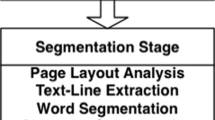Abstract
The field of optical character recognition for the Arabic text is not getting much attention by researchers comparing to Latin text. It is only in the last two decades that this field was being exploited, due to the complexity of Arabic writing and the fact that it demands a critical step which is segmentation; first from text to lines, then from lines to words and finally from words to characters. In case of historical documents, the segmentation is more complicated because of the absence of writing rules and the poor quality of documents. In this paper we present a projection-based technique for the segmentation of text into lines of ancient Arabic documents. To override the problem of overlapping and touching lines which is the most challenging problem facing the segmentation systems, firstly, pre-processing operations are applied for binarization and noise reduction. Secondly a skew correction technique is proposed beside a space following algorithm which is performed to separate lines from each other. The segmentation method is applied on four representations of the text image, including an original binary image and other three representations obtained by transforming the input image into: (1) smeared image with RLSA algorithm, (2) up-to-down transitions, (3) smoothed image by gaussian filter. The obtained results are promising and they are compared in term of accuracy and time cost. These methods are evaluated on a private set of 129 historical documents images provided by Al-Qaraouiyine Library.
Access this chapter
Tax calculation will be finalised at checkout
Purchases are for personal use only
Similar content being viewed by others
Notes
- 1.
Al-Qaraouiyine Library: Founded in 860 in Fez, Morocco. Al-Qaraouiyine is believed to be the oldest working library in the world. It is part of Al-Qaraouiyine University which, according to the UN, is the oldest operating educational institute in the world.
References
Zoizou, A., Zarghili, A., Chaker, I.: A new hybrid method for Arabic multi-font text segmentation, and a reference corpus construction. J. King. Saud. Univ. – Comput. Inf. Sci. (2018). https://doi.org/10.1016/j.jksuci.2018.07.003
Katsouros, V., Papavassiliou, V.: Segmentation of handwritten document images into text lines. Image Segmentation (2012). https://doi.org/10.5772/15923
Saabni, R., Asi, A., El-Sana, J.: Text line extraction for historical document images. Pattern Recognit. Lett. 35, 23–33 (2014). https://doi.org/10.1016/j.patrec.2013.07.007
Zahour, A., Taconet, B., Mercy, P., Ramdane, S.: Arabic hand-written text-line extraction. In: Proceedings International Conference Document Analysis Recognition, ICDAR 2001-January, pp. 281–285 (2001). https://doi.org/10.1109/ICDAR.2001.953799
Pal, U., Datta, S.: Segmentation of Bangla unconstrained handwritten text. In: Proceedings International Conference Document Analysis Recognition, ICDAR 2003-January, pp. 1128–1132 (2003). https://doi.org/10.1109/ICDAR.2003.1227832
Boussellaa, W., Zahour, A., Elabed, H., et al.: Unsupervised block covering analysis for text-line segmentation of Arabic ancient handwritten document images. In: Proceedings - International Conference Pattern Recognition, pp. 1929–1932 (2010). https://doi.org/10.1109/ICPR.2010.475
Garz, A., Fischer, A., Bunke, H., Ingold, R.: A binarization-free clustering approach to segment curved text lines in historical manuscripts. In: Proceedings International Conference Document Analysis Recognition, ICDAR 1290–1294 (2013). https://doi.org/10.1109/ICDAR.2013.261
Garz, A., Fischer, A., Sablatnig, R., Bunke, H.: Binarization-free text line segmentation for historical documents based on interest point clustering. In: Proceedings- 10th IAPR International Work Document Analysis System DAS 2012, pp. 95–99 (2012). https://doi.org/10.1109/DAS.2012.23
Yin, F., Liu, C.L.: Handwritten text line extraction based on minimum spanning tree clustering. In: Proceedings 2007 International Conference Wavelet Analysis Pattern Recognition, ICWAPR 2007 3, pp. 1123–1128 (2008). https://doi.org/10.1109/ICWAPR.2007.4421601
Shi, Z., Setlur, S., Govindaraju, V.: Text extraction from gray scale historical document images using adaptive local connectivity map. In: Proceedings International Conference Document Analysis Recognition, ICDAR 2005, pp. 794–798 (2005). https://doi.org/10.1109/ICDAR.2005.229
Koo, H.L., Cho, N.I.: Text-line extraction in handwritten Chinese documents based on an energy minimization framework. IEEE Trans. Image Process. 21, 1169–1175 (2012). https://doi.org/10.1109/TIP.2011.2166972
Capobianco, S., Marinai, S.: Text line extraction in handwritten historical documents. In: Grana, C., Baraldi, L. (eds.) IRCDL 2017. CCIS, vol. 733, pp. 68–79. Springer, Cham (2017). https://doi.org/10.1007/978-3-319-68130-6_6
Ouwayed, N., Belaïd, A., Auger, F.: General text line extraction approach based on locally orientation estimation. Doc. Recognit. Retr. XVII 7534, 75340B (2009). https://doi.org/10.1117/12.839518
Casey, R.G., Lecolinet, E.: Survey of methods and STR in character segmentation. IEEE Anal. 18, 690–706 (1996). https://doi.org/10.1109/34.506792
Likforman-Sulem, L., Hanimyan, A., Faure, C.: A hough based algorithm for extracting text lines in handwritten documents. In: Proceedings International Conference Document Analysis Recognition, ICDAR 2, pp. 774–777 (1995). https://doi.org/10.1109/ICDAR.1995.602017
Wong, K.Y., Casey, R.G., Wahl, F.M.: Document analysis system. IBM J. Res. Dev. 26, 647–656 (2010). https://doi.org/10.1147/rd.266.0647
Savitzky, A., Golay, M.J.E.: Smoothing and differentiation of data by simplified least squares procedures. Anal. Chem. 2, 1627–1639 (1964). https://doi.org/10.1021/ac60214a047
Author information
Authors and Affiliations
Corresponding author
Editor information
Editors and Affiliations
Rights and permissions
Copyright information
© 2019 Springer Nature Switzerland AG
About this paper
Cite this paper
Zoizou, A., Zarghili, A., Chaker, I. (2019). Skew Correction and Text Line Extraction of Arabic Historical Documents. In: Smaïli, K. (eds) Arabic Language Processing: From Theory to Practice. ICALP 2019. Communications in Computer and Information Science, vol 1108. Springer, Cham. https://doi.org/10.1007/978-3-030-32959-4_13
Download citation
DOI: https://doi.org/10.1007/978-3-030-32959-4_13
Published:
Publisher Name: Springer, Cham
Print ISBN: 978-3-030-32958-7
Online ISBN: 978-3-030-32959-4
eBook Packages: Computer ScienceComputer Science (R0)




